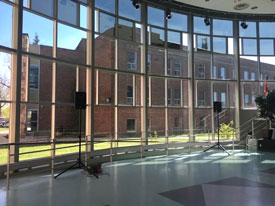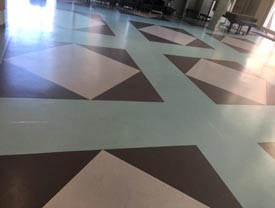In a recent issue of Canadian Teacher Magazine, Bradford & Schmidt (2016) discussed ways teachers can make cross-curricular connections in elementary school classrooms. According to Drake and Reid (2010), fusing learning outcomes from different subject areas results in academic performance equal to, or better than, discipline-based programs. Although there are countless ways to tie subject areas together (e.g., science and art, music and language arts, physical education and social studies) this article has been written to share practical ideas of integrating mathematics with physical education. More specifically, we wish to impart exciting and rewarding ways that “Math Trails” can help students experience learning benefits such as “making meaningful connections between subjects” (Alberta Education, 2007).
What are Math Trails?
When engaged in Math Trails, students stop at designated sites along a route and explore math in the environment. “As youngsters discover real-world shapes, patterns, numbers, data, symmetry and reflections—to name a few examples—their eyes open to the mathematics in their world. They become MATH DETECTIVES—posing questions and solving problems as well as documenting and communicating their discoveries in multiple ways” (English, Humble & Barnes, 2010, p. 407).
Using Math Trails with your Students
There are no rules about how to use Math Trails with your students—simply make it work for your students’ learning context! You could begin with just one stop on a trail, or it could be within the school or school grounds. Equip each student with a clipboard, pencil and activity sheet with pre-determined questions for each stop. Richardson (2004) recommended that “the students work in pairs or teams, both to make the excursion manageable and because the trail is designed to stimulate communication of mathematical ideas” (p. 13). Follow up the Math Trail activity with a classroom discussion, allowing students to compare their problem-solving strategies and solutions, and to share any challenges or additional questions they may have generated on the trail (English, Humble & Barnes, 2010).
Benefits to Student Learning in Physical Education and Mathematics
Physical Education
In addition to providing students with opportunities to experience physical activity, functional fitness, cooperation and enjoyment, Math Trails help students develop goal-setting, leadership, communication and orienteering skills. As students head out on the Math Trails, they can be introduced to alternative environments, various methods of problem-solving, and an array of navigational skills while utilizing various fundamental movements skills and building self-confidence.
Mathematics
Curricula across Canada encourage educators to engage students in mathematical processes. On a Math Trail, students certainly have opportunities to make connections between mathematics and “real-world phenomena, [so] students begin to view mathematics as useful, relevant and integrated” (Alberta Education, 2014, p. 5). As students work with their peers on a Math Trail, they will be communicating their reasoning, two other valuable mathematical processes. The mathematical content of a Math Trail can be tailored to address particular grade level outcomes. Start with looking for patterns, shapes and numbers in the environment, and then questions can be developed to target specific learning outcomes.
Teaching Considerations for Math Trails
- Ensure the Math Trail is developmentally appropriate.
- Plan and develop the Math Trail ahead of time (and, perhaps complete it yourself first).
- Examine the route for safety.
- Consider students with special needs when planning the Math Trail.
- Circulate around the Math Trail while students are completing the activity sheet.
- Plan a developmentally appropriate and safe activity for students who complete the Math Trail quickly.
- Designate parent/guardian volunteers or buddies from an older class to assist in supervision, if the Math Trail will be outside the school location or in an area where young students may be out of sight.
An Example of a (modified) Math Trail
To help you gain a more thorough understanding of Math Trails, we have included a few modified task examples that were developed for pre-service elementary school teachers. The actual examples used included an additional focus on physical education learning outcomes (e.g., fundamental movement skill development), too. The modified examples are followed by an explanation of student responses.
Discovery Point Example 1

Wow Windows – About how many individual window panes are there in the “T” building? How did you estimate?
Student Responses: At this Discovery Point, the spatial structure of the windows prompted students to use the patterns they noticed to estimate the number of windows efficiently. As students compared their estimations with each other, rich conversations involving pattern, shape and number ensued:
I counted the top horizontal row of windows and there were 16 window panes. I saw there were 5 rows but 2 rows had double the number of panes so I thought 7 adjusted rows x 16 windows each is about 110 window panes.
I noticed a vertical core in the pattern with 14 windows in the core unit. The core repeats 8 times, so 8 core units x 14 windows each is about 120 windows.
Students could verify that their different strategies produced close estimations.
Discovery Point Example 2
 Exploring the Area – Check out the tile design on the floor of the square inscribed in a square. How do you think the area of the outer square compares to the area of the inner square?
Exploring the Area – Check out the tile design on the floor of the square inscribed in a square. How do you think the area of the outer square compares to the area of the inner square?
Student Responses: The interesting tile design on the floor provided an opportunity to think about shape and area. We deliberately did not bring any standard measuring devices on the Math Trail so that students could problem solve how to measure or estimate using non-standard units available to them. Many students used their own feet as handy non-standard units and measured that the big square was about 7 feet by 7 feet, therefore approximately 49 square feet. The inner square was about 5 feet by 5 feet or 25 square feet; so they reasoned that the outer square was double the area of the inner square. Other students used visualization and imagined transforming the shapes to cover each other:
Imagine folding the dark outer triangles in over the white inner square. I think the dark triangles would cover the same area as the white square.
Then they confirmed their visual estimation with some non-standard measurements to discover how the triangles would fold in and cover the square.
Discovery Point Example 3
Shapely Sculpture – When looking at W. Gregory’s “Kubos” sculpture, respond to the following questions:
- How would you describe the sculpture to someone who can’t see it, so they could visualize it?
- What shapes are the faces of the sculpture? How many faces are there?
- How many lines of symmetry can you see?
 Student Responses: The ways students described the shape were varied and fascinating:
Student Responses: The ways students described the shape were varied and fascinating:
It is like a Rubik’s cube resting on one vertex with two slices missing. There are two thick letter “U’s” that are attached at the top.
The unusual nature of the shape prompted us to refine our understanding of a face. To help visualize the shape and count the faces, one student chose to build the sculpture out of multi-link cubes when back in the classroom. This drawing encouraged the student to make connections to area and volume, extending the task to determine the surface area and volume of the multi-link cube sculpture.
Discovery Point Example 4
Data on the Pedway – When standing in the middle of the pedway over the busy university street, choose one direction and look outside at the traffic passing underneath. For three minutes, collect data about the vehicles that pass underneath. How many cars, trucks, vans, buses, and other vehicles pass in one direction in three minutes? After collecting your data, display your information in a table or graph format. Write two questions you could answer using this data.
Student Responses: Initially, many of the student questions did not involve significant analysis (e.g., “Were there more trucks or cars?”). To prompt further reasoning, the students were asked, “Why do you think the city’s traffic engineers might collect this sort of data? What questions might they have?” This prompt sparked interesting discussion about how engineers may evaluate the need for a pedway or how traffic is managed during the pedway construction process. Back in the classroom, a class discussion took place about the most effective ways to display the data (e.g., type of graph or table) based on the question being investigated.
Additional Examples
Discovery Point Example: Calculating Time – As you are travelling from the “T” building (front doors), calculate the time it takes to travel to the north building (front doors). Describe in one sentence how there can be variability with this discovery (among classmates).
Discovery Point Example: Discovery of Facts – Throughout the university campus grounds (inside or outside), write two facts that can be tied to curricular outcomes in either Physical Education, Math, or Social Studies (or integrated).
Pre-Service Student Remarks
Math Trails offer so much to our students. When watching our pre-service teachers engage in Math Trails, the positive comments were plentiful, and the overall learning was impactful. Student comments such as the ones below illustrate the immense learning potential for all students.
When you take part in a Math Trail, it’s hard not to come across more math within our environment.
Being able to move around freely really helped my motivation and overall focus on the task.I can really see this working in my future elementary school teaching. What a terrific way to get students to really love math!
Wow, everywhere I look now, I’m asking myself math questions … and, I’m liking it!
Concluding Thoughts
Math Trails are excellent teaching tools for student learning. It is hoped you can discover ways in and around your school environment to organize Math Trails that your students can participate in throughout the year. Take a look around your school environment and try to identify Math Trail tasks that you can create for your students. We are certain you and your students will experience enjoyment, goal-setting, cooperation, physical activity, fundamental movement skill development, and a whole bunch of mathematical thinking!
Now, let’s hit the Math Trails!
References
Alberta Education (2007, Updated 2014), Mathematics Kindergarten to Grade 9 Program of Studies. Retrieved from education.alberta.ca/media/464621/k_to_9_math_pos.pdf
Bradford, B. & Schmidt, E. (2016). Making Cross-Curricular Connections. Canadian Teacher Magazine. (Issue: April/May 2016). p. 16-17.
Drake, S.M., & Reid, J. (2010). Integrated Curriculum: Increasing Relevance While Maintaining Accountability. The Literacy and Numeracy Secretariat. (September 2010).
English, L.D., Humble, S., & Barnes, V.E. (2010). Trailblazers. Teaching Children Mathematics, 16(7), 402-409.
Richardson, K.M. (2004). Designing Math Trails for the Elementary School. Teaching Children Mathematics, 11(1), 8.
Supporting Resources
Math Trails: comap.com/highschool/projects/mathtrails/MathTrails.pdf
Geometry Playground: Walk a Math Trail: exploratorium.edu/geometryplayground/mathtrails.php
The Canadian Math Trail: brocku.ca/cmt/English/trail.htm
Hot Math Trails: An Internet Hotlist on Math Trails: britton.disted.camosun.bc.ca/geometry/mathtrail.html
ABOUT THE AUTHORS
Brent Bradford
Brent Bradford (PhD) is an Assistant Professor (Faculty of Education) at Concordia University of Edmonton. Along with extensive teaching experiences at the K – 9 school level, Brent served as a Teacher Educator from 2009 – 2014 (University of Alberta) while pursuing graduate work. Brent’s teaching has been recognized with awards at both the school and university levels. Brent serves on PHE Canada’s Advisory Board for Physical Education and Physical Literacy. Brent can be reached at brent.bradford@concordia.ab.ca.
Carrie Watt
Carrie Watt (MEd) is a Sessional Instructor of Mathematics Elementary Education at Concordia University of Edmonton and University of Alberta. Carrie enjoys helping students of all ages enjoy challenging mathematics, from a Math Club for elementary school children to teaching pre-service teachers. Carrie can be reached at carrie.watt@concordia.ab.ca or cwatt1@ualberta.ca.
This article is from Canadian Teacher Magazine’s Jan/Feb 2017 issue.












